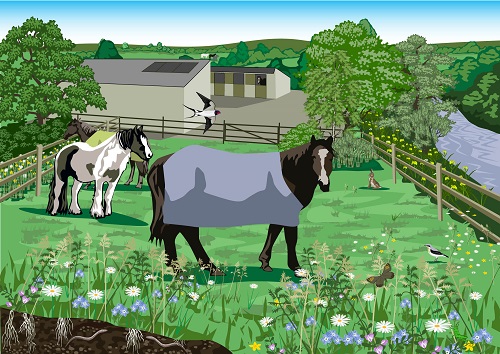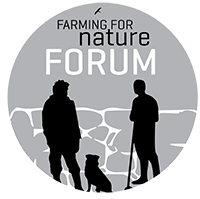EQUINE
Here are some practical ways to take climate action and enhance biodiversity on your equine farm
Climate & Biodiversity actions full doc (pdf)
Equine section only (pdf)
“Through working with FFN I am amazed by all the larger more commercial farmers having those light bulb moments when they questioned all they were putting into their farm (not just fertilizer and chemicals but also labour) and weighing up what they get out of it in return – and then making the change and not looking back – less costs, better life, more time for family.” Nia O’Malley, Equine and beef farmer and FFN Ambassador, Co. Galway.
1. Pastures & soil
Healthy soils store carbon
Healthy, biodiverse pasture has a high carbon storage capacity. High grazing pressure from horses can lead to long-term damage of soils. Horses will also select for certain plants, meaning that high stocking rates or intensive grazing will reduce the diversity of the sward over time.
- Consider how many horses are on the farm – is there enough pasture to allow for daily turnout but prevent overgrazing, or would lowering the number result in a healthier farming system long-term?
- Avoid ‘sacrifice paddocks’ – once damaged by poaching, your soil will take many years to recover
- Maintain species-rich swards to naturally fix nitrogen and improve drainage and drought tolerance
- Move feeding areas and water troughs regularly to prevent poaching and enrichment
- Maintain permanent pastures – cultivation to reseed will reduce diversity and release carbon from the soil
- Avoid compacting your pasture with increasingly heavy farm machinery
- Avoid creating bare patches of soil – bare soil releases carbon into the atmosphere
- Maximise turn-out to minimise the need for hard feed – the production of soya based hard feed is contributing to rapid destruction of the Amazon rainforest
- When buying horses, consider our world famous native breeds (i.e. Connemara ponies and the Irish draught). These breeds are fantastic all-rounders, happily live out year rounds, are good doers and require less land (and feed) to maintain good condition.
2. Fertilizers
The manufacture of chemical fertilisers generates ~1.4% of all carbon dioxide emissions. Furthermore, the application of fertilisers releases nitrous oxide, a gas with 300 times the global warming potential of carbon dioxide. To reduce fertilizer use but still maximize grass growth:
- Create a nutrient management plan
- Sow horse-friendly multi-species swards to naturally fix nitrogen
- Soil test paddocks regularly – maximise nutrient uptake by crops by maintaining optimum soil pH
- Switch CAN for protected urea
- Correctly compost horse manure before spreading – there are lots of online videos about making the very best compost heaps!
- Spread fertiliser and farmyard manure on warmer days (soil temp at least 6°C)
- Include nitrogen fixing legumes in swards or feed crops
- Use GPSs and tractor sensors for targeted spreading
Co-benefits for farmers
- Healthy stock – diverse swards contain a wide range of vitamins, minerals and natural anthelmintics (dewormers)
- Healthy soil – will produce higher grass yields and have a lower weed burden
- Improved farm self-sufficiency and climate resilience
3. Trees, scrub & hedgerows
Woody vegetation captures carbon.
- In less productive areas, fence out horses to allow for natural regeneration of trees and scrub
- Plant horse friendly native hedgerows
- Allow existing hedgerows to grow tall and wide
- Plant some native trees in larger pastures to provide shade and shelter for the future
- Diversify farm enterprises by planting a native woodland
- Retain, enhance or create copses and scrubland
Co-benefits for farmers
Woody vegetation can:
- provide diverse grazing
- provide shade & shelter
- improve animal welfare
- enhance biodiversity
- diversify farm enterprises
4. Water management
Our water bodies (rivers, lakes and oceans) naturally work together to support biodiversity and to store carbon. When water bodies are polluted, these systems break down. Almost half of Irish surface waters are not in good health and the situation is deteriorating. Help to restore our water bodies by eliminating harmful farm run-off:
- Manage your muckheap!! Run-off from muckheaps can cause havoc in watercourses. Keep your muck heap on a dry surface, cover stored muck with a reusable tarpaulin and control any run-off
- Research how to compost horse manure on your farm – when composted correctly (well aerated), it can be used as a brilliant natural fertiliser and without the risk of increasing your paddock’s parasite load
- Make a simple list of the potential sources of run-off from your yard and how you might eliminate them. Some of these (e.g. muck, herbicides) are more obvious than others (e.g. veterinary products (e.g. wormers) in horse manures, wash-bay run-off, spoil from tractor tyres, micro-plastics from arena surfaces).
- Before spraying herbicides, try alternative methods of weed control e.g. topping, improving soil fertility or rotational grazing. As many herbicides are water soluble (e.g. MCPA, 2,4-D), it is almost impossible to ensure they do not end up in watercourses after application. Recent research has detected herbicides in 38% of drinking water wells tested in Ireland.
- Reduce nutrient run-off from pasture: plant buffer strips, field margins and hedgerows to slow the flow of nutrients; never spread natural or synthetic fertilizers when rain is due.
Co-benefits for farmers
- Reduced input, labour, fuel and machinery costs
- Cleaner water and good health – research has detected herbicides in 38% of drinking water wells tested in Ireland!
5. Energy & fuel
Maximising energy efficiency and moving away from fossil fuels are two ways in which equine enterprises can minimise their carbon footprint.
- Consider renewable energy – is there a roof that could support solar panels? Can you use a solar powered electric fencer?
- Turn it off when not in use! Arena and yard lights, heaters, office computers etc. all contribute to the farm carbon footprint
- Fix leaky pipes and troughs! Drinking water production and supply requires energy yet >43% of treated drinking water in Ireland is lost to leaks.
- Minimise or eliminate the use of chemical fertilisers and herbicides – these are manufactured using fossil fuels
- Plastics are also produced using fossil fuels – avoid suppliers that use excessive packaging
- Maximise turnout at grass to minimise emissions from the production and transport of hay/haylage, bedding and hard feed. Could you grow some of your own feed and bedding (e.g. hay, oats, straw) on farm?
Co-benefits for farmers
- Reduced fuel and input costs
- Reduced energy costs
- Improved farm self-sufficiency and climate resilience
Curious? Have you run the numbers for lowering your stocking rate?
When all annual input costs are considered (e.g. feed, fertilizer, fencing, fuel, and, importantly, LABOUR!), could it make financial as well as climate sense to reduce numbers slightly, thereby taking the pressure off your pastures?
Nature co-benefits
Climate action on equine holdings can benefit nature by creating:
- More species-rich and diverse landscapes, supporting native fungi, insects, birds, mammals and more!
- Healthier rivers, lakes, estuaries and oceans, rich with life
- Habitat for our native species to feed and breed
- Nature-rich landscapes – loud with humming insects and singing birds
- A model for other equestrian enterprises; when we experience nature on another holding we are more likely to want to protect it on our own!
Nothing beats nature for providing natural climate change adaptation and mitigation. Boosting biodiversity, from the soil to the treetops, will help your farming system to remain productive and resilient in the face of increasingly unpredictable weather events.
“It was when I had the chance to channel my creativity into a tangible action; give a small piece of land back to natural processes, change a grazing technique, plant trees or use native seeds, that I felt part of the process of creation. I felt alive. I think we must balance the very grim and challenging information with the incredible and inextinguishable human drive to create beauty. Our challenge as farmers is to align our concept of beauty with that of the essential beauty of nature’s systems, our life support systems” Kate Egan, Horse owner, horticulturalist and FFN Ambassador, Co. Westmeath.


